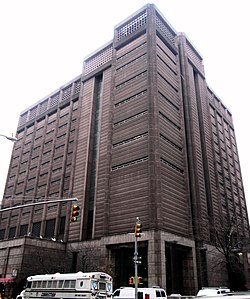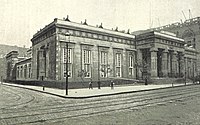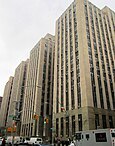The Tombs
The Tombs was the colloquial name for Manhattan Detention Complex (formerly the Bernard B.
Kerik Complex), a former municipal jail at 125 White Street in Lower Manhattan, New York City. It was also the nickname for three previous city-run jails in the former Five Points neighborhood of lower Manhattan, in an area now known as the Civic Center.
 | |
| Location | New York City |
|---|---|
| Status | Active |
| Security class | Municipal Jail |
| Opened | 1838 (original building) |
| Former name | Halls of Justice, Manhattan House of Detention |
| Managed by | New York City Department of Corrections |
| Director | Commissioner Joseph Ponte |
The original Tombs was officially known as the Halls of Justice, built in 1838 in an Egyptian Revival architectural style, similar in form to a mastaba. It may have been this style that caused it to be called "the Tombs", although other theories exist. It was built as a replacement for the Colonial-era Bridewell Prison located in City Hall Park, built in 1735. The new structure incorporated material from the demolished Bridewell to save money.
The four buildings known as The Tombs were:
- 1838–1902, New York City Halls of Justice and House of Detention
- 1902–1941, City Prison
- 1941–1974, Manhattan House of Detention
- 1983–2023, Manhattan Detention Complex (known as the Bernard B. Kerik Complex from 2001 to 2006)
History
Halls of Justice and House of Detention, 1838–1902
The first complex to have the nickname was an Egyptian Revival design by John Haviland completed in 1838. There was a rumor at the time that the building was inspired by a picture of an Egyptian tomb that appeared in John Lloyd Stephens' Incidents of Travel in Egypt, although this appears to be untrue. The building was 253 feet, 3 inches in length and 200 feet, 5 inches wide, and it occupied a full block, surrounded by Centre Street, Franklin Street, Elm Street (today's Lafayette), and Leonard Street. It initially accommodated about 300 prisoners, and $250,000 was allocated in 1835 to build it, but various cost overruns occurred prior to completion of the project.
The building site had been created by filling in the Collect Pond that was the principal water source for Colonial New York City. Industrialization and population density by the late 18th century resulted in the severe pollution of the Collect, so it was condemned, drained, and filled in by 1817. The landfill job was poorly done, however, and the ground began to subside in less than 10 years. The resulting swampy, foul-smelling conditions transformed the neighborhood into a slum known as Five Points by the time that prison construction started in 1838. The heavy masonry of Haviland's design was built atop vertical piles of lashed hemlock tree trunks in a bid for stability, but the entire structure began to sink soon after it was opened. This damp foundation was primarily responsible for its unsanitary conditions in the decades that followed. Charles Dickens wrote about the jail in American Notes: "Such indecent and disgusting dungeons as these cells, would bring disgrace upon the most despotic empire in the world!"
The Tombs' formal title was The New York Halls of Justice and House of Detention, as it housed the city's courts, police, and detention facilities. It was a notable example of Egyptian Revival architecture, although opinion varied greatly concerning its actual merit. As Dickens wrote: "What is this dismal fronted pile of bastard Egyptian, like an enchanter's palace in a melodrama?"
The prison was well known for its corruption and was the scene of numerous scandals and escapes during its early history. A fire destroyed part of the building on November 18, 1842, the same day that a notorious killer named John C. Colt was due to be hanged. Apparently it was an escape attempt on Colt's part that failed, and he fatally stabbed himself in his cell. Convicted murderer and New York City politician William J. Sharkey earned national notoriety for escaping from the prison disguised as a woman on November 22, 1872. He was never captured and his fate is unknown.
Rebecca Salome Foster, a prison relief worker and missionary, became known as "the Tombs Angel" for her efforts to help and advocate on behalf of the many poor people held in squalid conditions at the Tombs. A monument to her, built in 1902 and put in storage in 1940, was rededicated in 2019 in the New York State Supreme Court's lobby.
City Prison, 1902–1941
In 1902, the 1838 building was replaced by a million-dollar City Prison featuring an eight-story Châteauesque facade with conical towers along Centre Street, bounded by Centre Street, White Street, Elm Street (today's Lafayette), and Leonard Street.
The architects were Frederick Clarke Withers and Walter Dickson from Albany, who had been partners since the 1880s. This was their final major commission. In September 1900, the architects complained that construction would be delayed for a year and cost an additional $250,000 due to the unnecessary insertion of corrupt Tammany Hall architects Horgan and Slattery into the project.
The building was connected to the 1892 Manhattan Criminal Courts Building with a "Bridge of Sighs", crossing four stories above Franklin Street. There was also an Annex with another 144 cells that was finished in 1884.
Manhattan House of Detention, 1941–1974
The 1902 prison was replaced in 1941 by a high-rise facility across the street on the east side of Centre Street. The 795,000 square foot Art Deco architecture facility was designed by architects Harvey Wiley Corbett and Charles B. Meyers.
The facility is the northernmost of the four 15-story towers of the New York City Criminal Courts Building at 100 Centre Street, bounded by Centre Street, White Street, Baxter Street, and Hogan Place. The three southern towers are wings of a single integrated structure sharing a five-story "crown" which house the city's Criminal and Supreme Courts, city offices, and various departments, including the headquarters of the Department of Corrections. The northern tower is freestanding, with the separate address of 125 White Street. It was officially named the Manhattan House of Detention for Men (MHD), although it was still referred to popularly as The Tombs.
By 1969, the Tombs ranked as the worst of the city's jails, both in overall conditions and in overcrowding. It held an average of 2,000 inmates in spaces designed for 925. Inmates rioted on August 10, 1970, after multiple warnings about falling budgets, aging facilities, and rising populations, and after an informational picket of City Hall by union correctional officers drawing attention to the pressures. Rioters took command of the entire ninth floor, and five officers were held hostage for eight hours, until state officials agreed to hear prisoner grievances and take no punitive action against the rioters. Despite that promise, Mayor John Lindsay had the primary troublemakers shipped upstate to the state's Attica Correctional Facility which likely contributed to the Attica Prison riot about a year later.
Within a month after the riot, the New York City Legal Aid Society filed a landmark class action suit on behalf of pre-trial detainees held in the Tombs. The city decided to close the Tombs on December 20, 1974, after years of litigation and after federal judge Morris E. Lasker agreed that the prison's conditions were so bad as to be unconstitutional. They shipped the remaining 400 inmates to Rikers Island, where conditions were not much better.
Manhattan Detention Complex, 1983–2023
The Manhattan Detention Complex consisted of a South Tower, the former Manhattan House of Detention remodeled and reopened in 1983, and a North Tower across White Street, completed in 1990. The complex housed only male inmates, most of them pretrial detainees. The total capacity of the two buildings was nearly 900 people.
The jail was named The Bernard B. Kerik Complex in December 2001 at the direction of New York City mayor Rudolph Giuliani. Kerik was commissioner of the New York City Department of Corrections from 1998 to 2000 before becoming police commissioner. New York City mayor Michael Bloomberg ordered Kerik's name removed after he pleaded guilty to two misdemeanors in 2006, committed during his tenure as a city employee.
In 2019, the New York City Council announced plans to build four new jails citywide to replace Rikers Island, including a high-rise jail tower on the site of the Tombs. The New York Daily News reported that the city planned to close the complex prior to the end of November 2020. The demolition of the Tombs attracted criticism from landlords, local residents, and prison-reform advocates. Opponents claimed the redevelopment would harm local residents and businesses. An injunction preventing the jail tower's construction was issued by the New York Supreme Court in 2020 but was overturned the next year. Two artists also filed a lawsuit to preserve artwork that was displayed on the Tombs' facade, but U.S. district judge Lewis A. Kaplan declined to grant an injunction, and seven murals were subsequently removed. The demolition of the Tombs was finally approved in April 2023 but was paused after further objections. Demolition continued despite objection by local residents.
Notable people
- Edward Coleman, first criminal executed at the prison in 1839
- Rebecca Salome Foster, prison relief worker known as "The Tombs Angel"
- Ernestine Schaffner, prison relief worker known as "The Tombs Angel"
- Vojislav Stanimirović (crime boss) YACS
- William M. Tweed, head of the Tammany Hall political ring, spent a year in the Tombs after his second trial in 1873
- Morris U. Schappes, American educator, writer, radical political activist, historian, and magazine editor, incarcerated in the Tombs after a 1941 perjury conviction obtained in association with testimony before the Rapp-Coudert Committee (investigating Communism in education in New York)
In November 2000, 16 people associated with the Opie and Anthony radio show were arrested and held in The Tombs overnight during a promotion for "The Voyeur Bus", a mostly glass bus carting topless women through Manhattan with a police escort.
References
Notes
Bibliography
- Gilfoyle, Timothy J. (2003). ""America's Greatest Criminal Barracks": The Tombs and the Experience of Criminal Justice in New York City, 1838–1897". Journal of Urban History. 29 (5): 525–554. doi:10.1177/0096144203029005002. OCLC 88513081. S2CID 144410853.
- Roth, Mitchel p. (2006). Prisons and Prison Systems: A Global Encyclopedia. Westport, Connecticut: Greenwood Press. ISBN 978-0-313-32856-5. OCLC 60835344.
Further reading
- Berger, Meyer (1983) [1942]. "The Tombs". The Eight Million: Journal of a New York Correspondent (Columbia University Press Morningside ed.). New York: Columbia University Press. pp. 23–35. ISBN 978-0-231-05710-3. OCLC 9066227. Archived from the original on September 27, 2007. Retrieved October 10, 2007.
- DeFord, Miriam Allen (1962). Stone Walls: Prisons from Fetters to Furloughs. Philadelphia: Chilton. OCLC 378834.
- Johnson, James A. (2000). Forms of Constraint: A History of Prison Architecture. Urbana: University of Illinois Press. ISBN 978-0-252-02557-0. OCLC 42434965.
- Sifakis, Carl (2003). The Encyclopedia of American Prisons. New York: Facts on File. ISBN 978-0-8160-4511-2. OCLC 49225908.
External links

- Manhattan Detention Complex on prisonpro.com
- New York Correction History Society timeline (includes photo)
- "Irish in New York" site, Census of prisoners in 1860
- Article on the building complex at the website of the New York Correction History Society
This article uses material from the Wikipedia English article The Tombs, which is released under the Creative Commons Attribution-ShareAlike 3.0 license ("CC BY-SA 3.0"); additional terms may apply (view authors). Content is available under CC BY-SA 4.0 unless otherwise noted. Images, videos and audio are available under their respective licenses.
®Wikipedia is a registered trademark of the Wiki Foundation, Inc. Wiki English (DUHOCTRUNGQUOC.VN) is an independent company and has no affiliation with Wiki Foundation.







